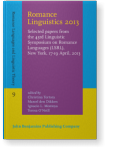Some notes on falloir, devoir, and the theory of control
This article sheds new light on the structure and meaning of sentences containing the French modal verbs devoir and falloir, as well as on the syntax and semantics of Control generally. Well-known and previously unnoticed empirical facts are examined that support the author’s novel contention that falloir and devoir are syntactically and semantically ambiguous. These data are also argued to offer indirect support for the analysis of Control clauses recently developed in Reed (2014: Ch. 6 and 7), according to which there is a theoretical primitive (pro) and it is associated with a “minimal” feature bundle consisting of just [−expletive] and [+N] syntactic features, with a separate, post-syntactic Theory of Control determining its understood phi-features.
References (40)
References
Authier, J.-Marc and Lisa Reed. 2009. “French Tough-Movement Revisited.” Probus 21 (1): 1–21. 

Bach, Emmon. 1979. “Control in Montague Grammar.” Linguistic Inquiry 10 (4): 515–531.
Barbiers, Sjef. 1995. The Syntax of Interpretation. The Netherlands: Holland Institute of Generative Linguistics.
Bošković, Željko. 2007. “The Syntax of Nonfinite Complementation: An Economy Approach.” Minimalist Syntax: The Essential Readings ed. by Željko Bošković and Howard Lasnik, 86–111. Oxford: Blackwell Publishers.
Bowers, John. 2002. “Transitivity.” Linguistic Inquiry 33 (2): 183–224. 

Chomsky, Noam. 1981. Lectures on Government and Binding. Dordrecht: Foris.
Chomsky, Noam and Howard Lasnik. 1995. “The Theory of Principles and Parameters.” The Minimalist Program, Noam Chomsky, 13–127. Cambridge, Mass.: MIT Press.
Culbertson, Jennifer and Géraldine Legendre. 2014. “Prefixal Agreement and Impersonal il in Spoken French: Experimental Evidence.” Journal of French Language Studies 24 (1): 83–105. 

Dubois, Jean. 1969. Grammaire structurale du français: La phrase et les transformations. Paris: Larousse.
Eide, Kristin. 2006. Norwegian Modals. Berlin: De Gruyter. 

Epstein, Samuel. 1984. “Quantifier-pro and the LF Representation of PRO.” Linguistic Inquiry 15 (3): 499–505.
Grinder, John. 1970. “Super Equi-NP Deletion.” Papers from the Sixth Regional Meeting of the Chicago Linguistic Society, 297–317. Chicago, Illinois: University of Chicago.
Harley, Heidi. 2011. “A Minimalist Approach to Argument Structure.” The Oxford Handbook of Linguistic Minimalism ed. by Cedric Boeckx, 427–448. Oxford University Press: Oxford.
Hornstein, Norbert. 1999. “Movement and Control.” Linguistic Inquiry 30 (1): 69–96. 

Huot, Hélène. 1974. Le verbe devoir: étude synchronique et diachronique. Paris: Klincksieck.
Jackendoff, Ray. 1990. Semantic Structures. Cambridge, Mass.: MIT Press.
Jackendoff, Ray, and Peter Culicover. 2003. “The Semantic Basis of Control in English.” Language 79 (3): 517–556. 

Kajita, Masaru. 1967. A Generative-Transformational Study of Semi-Auxiliaries in Present-Day American English. Ph.D. dissertation, Princeton University, Princeton, NJ.
Kayne, Richard. 1969. The Transformational Cycle in French. Ph.D. dissertation, MIT, Cambridge, MA.
Kayne, Richard. 1975. French Syntax: The Transformational Cycle. Cambridge, Mass.: MIT Press.
Kratzer, Angelika. 1981. “The Notional Category of Modality.” Words, Worlds, and Contexts. New Approaches in Word Semantics ed. by Hans-Jürgen Eikmeyer and Hannes Rieser, 38–74. Berlin: de Gruyter.
Kratzer, Angelika. 1991. “Modality.” Semantics: An International Handbook of Contemporary Research ed. by Arnim von Stechow and Dieter Wunderlich, 639–650. Berlin: de Gruyter.
Landau, Idan. 2000. Elements of Control: Structure and Meaning in Infinitival Constructions. Dordrecht: Kluwer Academic Publishers. 

Landau, Idan. 2004. “The Scale of Finiteness and the Calculus of Control.” Natural Language and Linguistic Theory 22 (4): 811–877. 

Landau, Idan. 2013. Control in Generative Grammar: A Research Companion. Cambridge: Cambridge University Press. 

Lasnik, Howard. 1992. “Two Notes on Control and Binding.” Control and Grammar ed. by Richard Larson, Sabine Iatridou, Utpal Lahiri, and James Higginbotham, 235–251. Dordrecht: Kluwer Academic Publishers. 

Martin, Roger. 2001. “Null Case and the Distribution of PRO.” Linguistic Inquiry 32 (1): 141–166. 

Perlmutter, David. 1970. “The Two Verbs Begin.” Readings in English Transformational Grammar ed. by Roderick Jacobs and Peter Rosenbaum, 107–277. Waltham, Mass: Ginn and Company.
Postal, Paul. 1970. “On Coreferential Complement Subject Deletion.” Linguistic Inquiry 1 (4): 439–500.
Reed, Lisa. 2014. Strengthening the PRO Hypothesis. Berlin: de Gruyter.
Rooryck, Johan. 2000. Configurations of Sentential Complementation. London: Routledge. 

Rooryck, Johan. 2007. “Control via Selection.” New Horizons in the Analysis of Raising and Control ed. by William Davies and Stanley Dubinsky, 281–292. Dordrecht: Springer. 

Ross, John. 1969. “Auxiliaries as Main Verbs.” Studies in Philosophical Linguistics Series I ed. by William Todd, 77–102. Evanston: Great Expectations Press.
Ruwet, Nicolas. 1972. Théorie syntaxique et syntaxe du français. Paris: Editions du Seuil.
Safir, Kenneth. 1985. Syntactic Chains. Cambridge: Cambridge University Press.
Sag, Ivan, and Carl Pollard. 1991. “An Integrated Theory of Complement Control.” Language 67 (1): 63–113. 

Williams, Edwin. 1985. “PRO and Subject of NP.” Natural Language and Linguistic Theory 3 (3): 297–315. 

Williams, Edwin. 1992. “Adjunct Control.” Control and Grammar ed. by Richard Larson, Sabine Iatridou, Utpal Lahiri, and James Higginbotham, 297–322. Dordrecht: Kluwer Academic Publishers. 

Zimmermann, Michael and Georg Kaiser. 2014. “On Expletive Subject Pronoun Drop in Colloquial French.” Journal of French Language Studies 24 (1): 107–126. 

Zubizarreta, Maria Luisa. 1983. “On the Notion ‘Adjunct Subject’ and a Class of Raising Predicates.” MIT Working Papers in Linguistics 5: 195–232.
Cited by (1)
Cited by one other publication
Reed, Lisa A.
2019.
Further Implications of French Devoir and Falloir for Theories of Control and Modality. In
Contributions of Romance Languages to Current Linguistic Theory [
Studies in Natural Language and Linguistic Theory, 95],
► pp. 65 ff.

This list is based on CrossRef data as of 25 july 2024. Please note that it may not be complete. Sources presented here have been supplied by the respective publishers.
Any errors therein should be reported to them.
